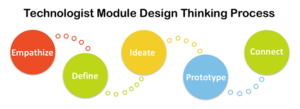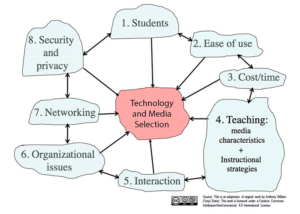My multimedia reflection revolves around eCampus’ Technologist module, which addresses the idea of differentiation and successfully using technology to address students’ specific needs. The first section of the module has to do with digital literacy, and it encourages readers to come up with their own definition after reading. Through this, the definition of digital literacy I concluded with was ” making an effort to remain up to date on the most beneficial technological resources for meaningfully interacting with specific types of students”. I came up with this definition because I feel as if it encompasses everything the module advocates, especially with regard to design-thinking. The module is heavily influenced by this idea of design-thinking, a term that more or less refers to the process of individuals who will benefit from the end product partaking in its creation. In the classroom, this can be a powerful tool as students attempt to solve complex problems that may exist in their specific scenario. Design-thinking is broken down into five sections: Empathize, Define, Ideate, Prototype, and Connect. Essentially, these five steps highlight the importance of putting yourselves in students shoes, identifying problems that may exist, creating potential solutions to these issues, testing these methods within the classroom while searching for constructive feedback, and ensuring that the technological tool you choose to utilize connects to curriculum expectations. After considering all these steps as a whole, I could not really determine which one I felt was most important because they all complement each other in the journey toward the final goal of successfully using technology to address differentiation. Despite this, I think connecting to curriculum could hold some more weight in terms of actually applying these methods into the classroom. As the article states, if what you’re doing is not relevant to curriculum, you might want to rethink your strategy/tool. This is something that some teachers might forget when using technology in the classroom. A tool may seem really cool to incorporate, but ensuring actual learning with respect to your subject area occurs is paramount.

Something that really stood out to me was the SECTIONS model, which is a step-by-step process to follow when choosing a technological tool. Before anything, students are prioritized first, and this is something that resonated with me deeply. I appreciate how the model and the module as a whole value students’ wants and needs before anything else because I feel as if this is something that some teachers lack when designing their lesson plans. If more teachers navigated through this module and attempted to incorporate the elements that are presented, learning would be a much more enjoyable and rewarding experience from K-12 and beyond.

As with my first multimedia reflection, I chose to go with a Twitter essay in my response to the information presented. Although we are encouraged to branch out and try different technological tools (as I did in the second one), I feel as if I can best present my ideas within the Twitter essay format. There are so many ways you can get across the main points of the module: writing about it, implementing polls, adding GIFs, and scattering pictures throughout the essay. I did enjoy using Coggle in my last reflection to try something new, but I did find it a bit limiting in terms of condensing a wide variety of ideas into small headings and subheadings/sentences. The way the module is set up is almost perfect for a Twitter essay since it more or less follows a suggested process to follow, which is rather easy to convey into tweets. This may be our last multimedia reflection of the year (sadly), but I definitely encourage all teachers to obtain at least some literacy with respect to Twitter as it can be a useful tool to incorporate into the classroom, especially in relation to class discussions. Without further ado, here is my Twitter essay. Enjoy!
1. Today, I'm going to be talking about the Technologist Module of eCampus Ontario's open PD modules. This specific module is an excellent resource for teachers who wish to integrate technology into the classroom as a way of addressing differentiation. #UWinDig #OntarioExtend
— Cameron (@Cameron0580332) February 16, 2019
